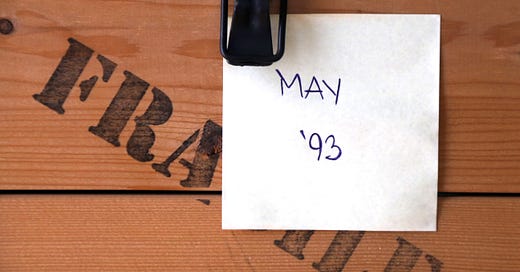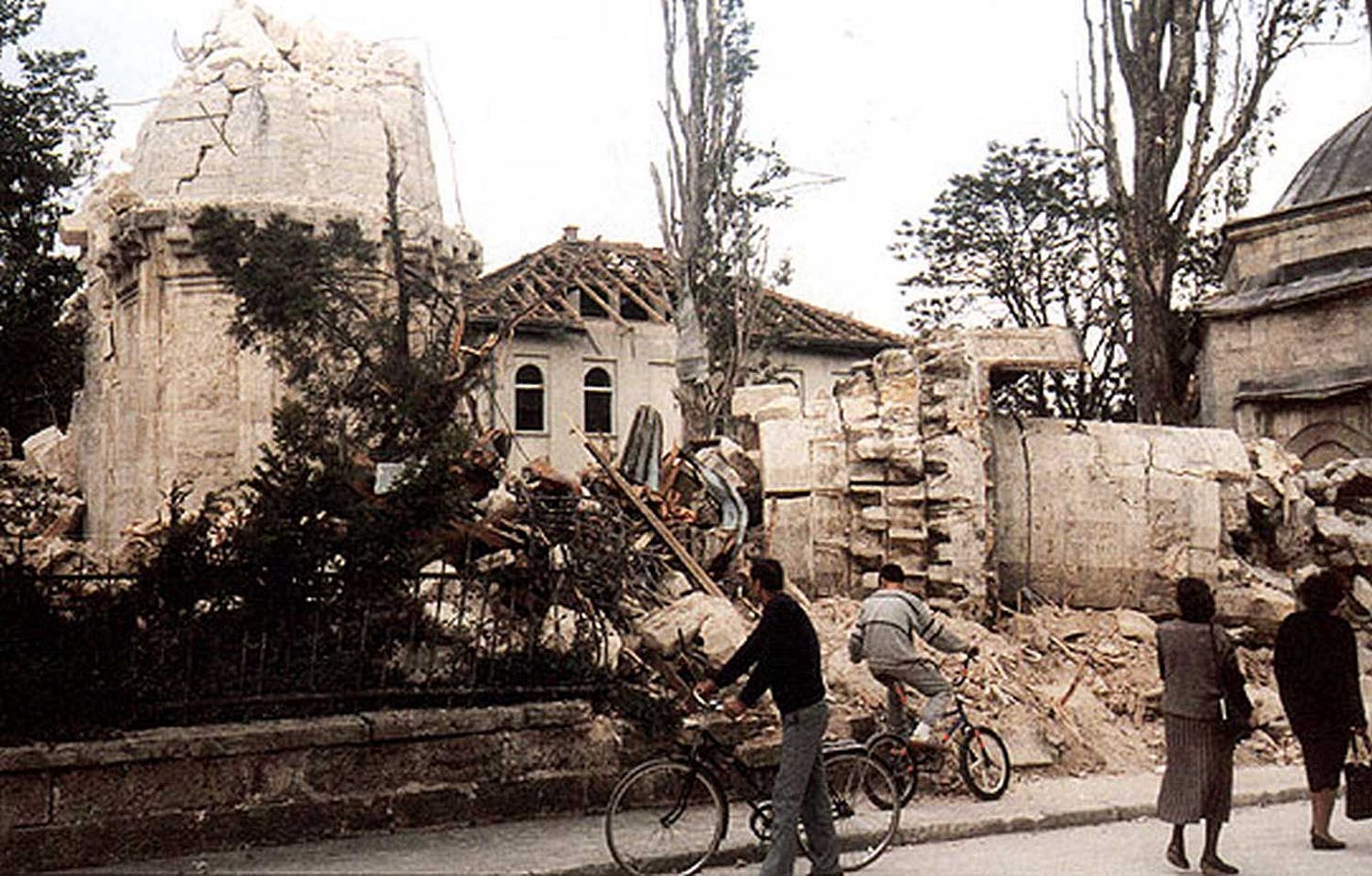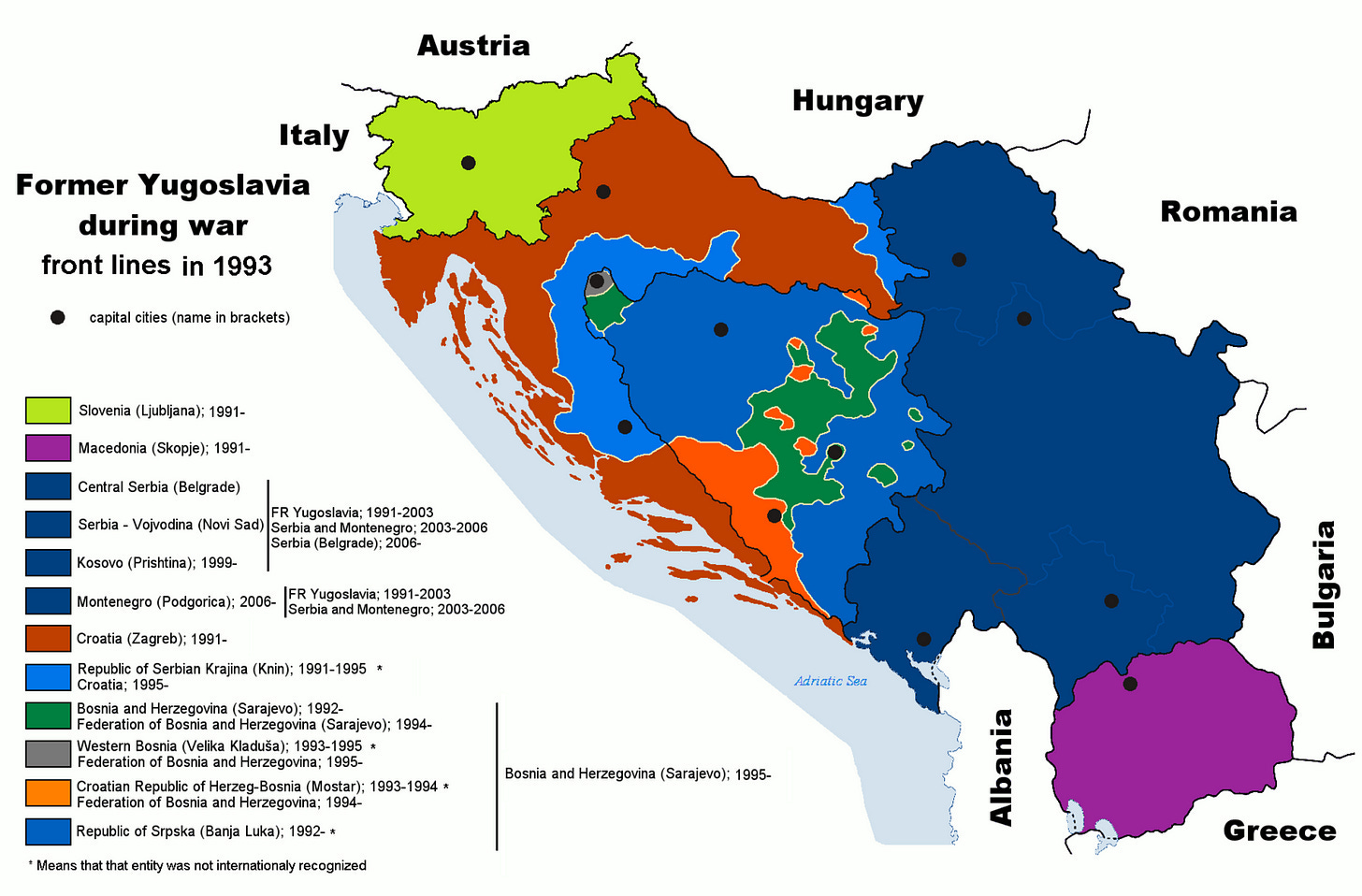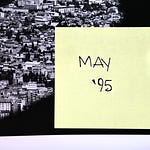May 1993.
After more than a year of war, Bosnia and Herzegovina is in total chaos, both diplomatically and militarily. All alliances have broken down and no strategy seems to guide the warring parties anymore [you can listen to the latest episode of BarBalkans - Podcast here].
Croats of Bosnia and Muslims are back to clashing fiercely, as shown by the Ahmići massacre.
At the same time, Serbs of Bosnia are attacking the left bank of the Drina River, but their stubborn opposition to the Vance-Owen Plan is making relations with Belgrade increasingly tense.
International diplomacy is in difficulty, because there is almost no ability to implement on the ground the great declarations, such as the definition of Srebrenica as a «protected area».
Serbs against Serbs
Serbian President Slobodan Milošević’ attempts to persuade Bosnian Serbs to sign the international peace plan become more intense at the beginning of the month.
On May 2, together with the Prime Minister of Greece, Konstantin Mitsotakis, and the European Community negotiator for the former Yugoslavia, David Owen, Milošević organizes an emergency session of the International Conference on the former Yugoslavia in Athens.
There, the President of Republika Srpska, Radovan Karadžić, agrees to sign the Vance-Owen Plan, only if it is also ratified by the Bosnian Serb Parliament (which has already rejected it twice).
It goes without saying, the 65 Bosnian Serb deputies gathered in Pale on May 5 - mostly military, war criminals and profiteers not interested in ending the conflict - refuse again.
They do not formally reject the Plan, but they do more. They decide to hold a popular referendum on whether to accept or reject it.
In Pale, Milošević is defeated politically by Ratko Mladić. The commander of the Republika Srpska Army succeeds in bringing together the radical wing and orders to bomb Žepa and Sarajevo while the session is ongoing, to demonstrate all his intransigence.
The following day the two 16th-century mosques in Banja Luka are destroyed.
As expected, the referendum on May 15 and 16 is a plebiscite. 96.87% of Bosnian Serb voters decide to reject the Vance-Owen Plan. The turnout is 9 out of 10 voters, about 1.2 million people.
The result is a surprise, but just because of the suicidal strategy.
Milošević’ Serbia - the “motherland” for Bosnian Serbs and the vital support for continuing the war - imposes the already threatened sanctions against Republika Sprska.
The border along the Drina River is closed to all incoming supplies from Serbia and Montenegro, except for humanitarian supplies.
Milošević is furious. Because of Bosnian Serbs’ decision, international sanctions will continue to burden the Federal Republic of Yugoslavia.
The international community is also shocked by the opposition of the Bosnian Serbs.
The UN Security Council is urgently convened on May 6. Resolution 824 extends the definition of «protected area» to Goražde, Sarajevo, Tuzla and Žepa, as already done for Srebrenica.
Again, this is nothing more than a vague Resolution, as it calls for the end of Bosnian Serb attacks on the towns along the Drina River, but with no sanctions in case of non-compliance.
On one hand France continues to pursue its appeasement policy. On the other hand the United States is beginning to lose interest in Bosnia, after months of turnarounds.
There is a growing feeling in Washington that it is better to focus on "containment”. It means preventing the expansion of violence beyond Bosnian borders, while waiting for the ethnic fury in the country to quiet down.
Bosniaks against Bosnian Croats
However, in May 1993 the ethnic fury does not seem to quiet down. In fact, it is quite the opposite.
After the Ahmići massacre on April 16, the situation worsens in the Lašva Valley (in Central Bosnia) between the two opposed sides: Bosnian Croats and Bosniaks, the Muslim of Bosnia.
All lead to the events of May 9 in Mostar. A city with a population of 130 thousand people until the outbreak of the war and with a harmonious ethnic composition: 35% of Bosniaks, 34% of Bosnian Croats and 19% of Bosnian Serbs.
Everything has changed with the beginning of the war, the flight of Bosnian Serbs and the influx of Muslim refugees. But especially with the exacerbation of ethnic hatred between the two prevailing groups.
This is why, after devastating Vitez and Gornji Vakuf, the troops of the Croatian Defense Council (the army of the Croatian Republic of Herzeg-Bosnia) siege Mostar. They search Muslims house to house on the left bank of the Neretva River.
Over two thousand Bosniaks are imprisoned in concentration camps, while the Turkish quarter is razed to the ground and the 17 historic mosques torn down.
The violence spreads to Jablanica, Konjic, Busovača and Kiseljak. It means the entire Neretva area, crucial for connections between the Adriatic Sea and Sarajevo and for control of the hydroelectric power plants in Central Bosnia.
The nationalist violence of Bosnian Croats is firmly supported across the border, in the “motherland” Croatia, led by President Franjo Tuđman. The same President who is referring to them as a «garrison of Christianity» in Bosnia.
Tuđman draws on ustascia rhetoric (the Croatian clerical-fascist movement, allied with Nazis and Italian fascists in World War II). A bit of nationalism, a bit of clericalism, a lot of ethnic hatred.
Thanks to the support of the Herzegovinian Mafia and the arms smuggling circles gathered around the President of the Croatian Republic of Herzeg-Bosnia, Mate Boban, Tuđman succeeds in sending four brigades of Croatian soldiers (passed off as Herzegovinian), 50 tanks and 200 pieces of heavy artillery into Bosnia.
All of this is done behind the back of the Parliament in Zagreb, which neither discusses nor authorizes the sending of weapons and soldiers.
Nevertheless, Tuđman’s exposure is excessive. At the point that on May 10 the UN Security Council warns Croatia that sanctions will be imposed in the event of non-compliance with the cease-fire.
The collapse of the Vance-Owen Plan
However, international diplomacy is not able to understand what is actually happening in the chaos of Bosnia and Herzegovina.
Also because something controversial is taking place on the Vance-Owen Plan, the peace plan that has not been implemented on the ground.
On one hand, Russia is pushing to implement the Plan even without the approval by Bosnian Serbs, providing for close cooperation between Russian and U.S. troops through the United Nations Protection Force (UNPROFOR).
But on the other hand, the first tombstone on the Plan is put by the Unites States, unwilling to send soldiers to the Balkans.
What results is a secret agreement between the U.S., Russia, Britain, France and Spain to scuttle the Vance-Owen Plan and replace it with an “Action Plan”. The aim is to mark a turning point in dealing with the Bosnian issue.
The new Action Plan is presented on May 22. It consists of 13 proposals for Bosnia and Herzegovina, drawn up with no involvement of the United Nations, the European Community, Germany, Italy and the Netherlands.
This Action Plan includes humanitarian assistance, sanctions, no-fly zone and protected areas, the possibility of closing the border between Serbia and Bosnia, and the establishment of an International Criminal Tribunal.
Unlike the Vance-Owen Plan, it does not have the priority of (somehow) safeguarding the territorial integrity of the Republic of Bosnia and Herzegovina. It aims to «end this terrible war and find a stable and just solution».
The Plan is brought to the UN Security Council on May 27. Before approving a Resolution, the UN Secretary-General, Boutros Boutros-Ghali, is asked to draft a working paper on protected areas.
To make them effective, Boutros-Ghali stresses the need for varying numbers of soldiers, depending on the target in each area. A symbolic presence of 110/2,200 military observers, or a substantial presence of 4,500/12,000 UN soldiers to protect them, or a high concentration of 15,000 Blue Helmets to defend them from attack.
When news of the new Action Plan arrives in Republika Srpska, Bosnian Serb politicians cheer for two reasons. Firstly, because they do not see it as an obstacle to the segregation of Bosniaks.
And secondly because intransigence on the Vance-Owen Plan seems to have payed back, also considering the political crises faced by Milošević in Belgrade.
After his political defeat in Pale on May 6, the Serbian President is defending himself against calls for resignation arriving also from the Holy Synod of the Orthodox Church. Milošević is considered direct responsible for the division among Serbs, as he is a descendant of the atheistic totalitarianism of Yugoslav communism.
The truth is that the collapse of the Vance-Owen Plan strengthens Milošević, precisely because of the new goal of the Action Plan: to end the war and no longer to safeguard the territorial integrity of Bosnia and Herzegovina.
The President of the Federal Republic of Yugoslavia Dobrica Ćosić’ head is the first falling.
He has sided with Milan Panić’ opposition in the December 1992 presidential elections in Serbia and he is now accused of conspiring to overthrow legitimate power in the Federation.
On May 31, President Ćosić is dismissed by the Federal Parliament, under Milošević’ pressure, as already done with former Federal Prime Minister Panić only five months before.

If you know someone who can be interested in this newsletter, why not give them a gift subscription?
Here is the archive of BarBalkans - Podcast:
And here you can find a summary of the past years:




















Share this post